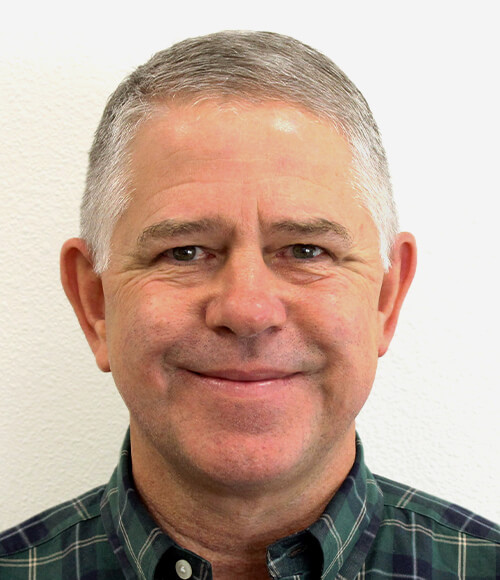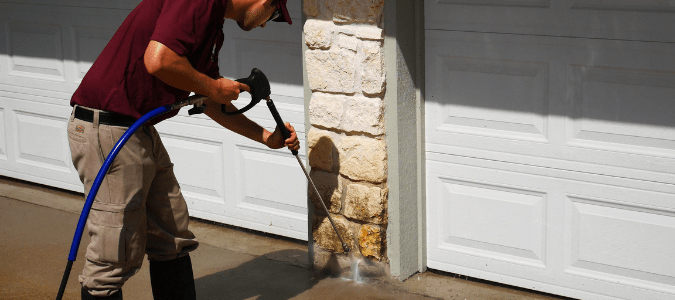
One of the most satisfying, but time-consuming, outdoor tasks you can take on is power washing your driveway and walkways. While you know that using a power washer can almost magically erase built-up dirt, debris and stains from practically any surface, you might wonder: Can power washing damage concrete?
The quick answer is yes, power washing can degrade a concrete surface.
You can notice visible damage from water pressure at the level at which even light-duty power washers can operate. Therefore, if you aren’t careful, you can cause irreversible damage to your driveway or patio. Also, some concrete is weaker than others, making some areas more vulnerable to developing lines, pitting or other surface imperfections, not to mention the deterioration to joints if mortar or joint sand is washed away during the process.
The top reasons for pressure washing damage are using the wrong nozzle, excessive pressure, spraying too close to a concrete surface and holding the nozzle on a particular spot for too long. As with any piece of equipment you purchase to use on your property, of course, you’ll want to read all instructions thoroughly before you get started.
Let’s now go into more detail about how you can give your concrete surfaces an upgrade without inadvertently causing any other problems.
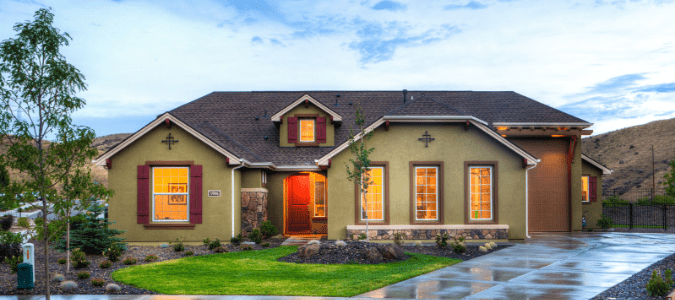
How To Pressure Wash Concrete
If done properly, pressure washing concrete can make a patio, driveway or walkway look as good as new in just a day’s time. For this post, you should know that we don’t make a distinction between power washing vs. pressure washing.
If you have decided you’d like to power wash your surfaces yourself, you’ll need to either purchase, rent or borrow a pressure washer. For many homeowners who only power wash once a year, renting a pressure washer makes more sense than finding the space to store a power washer the rest of the year, plus avoiding the hassle of needing to perform any maintenance or make repairs.
You’ll probably want to set aside the better part of an afternoon or morning to get the job done, depending on the size of the surface you’d like to work on. Power washing can be very dirty work, so wear shoes that you don’t mind getting ruined and pants to protect your legs from any rocks or loose materials that your pressure washer might send flying. Keep in mind that you may start power washing in one area and decide you need to pressure wash every surface on your property. Yes, it can be that addicting!
If you are using a pressure washer for the first time, or if you never got around to it, read through the instructions first. If you’re feeling any bit of hesitation, or if you realize you just don’t have the time or interest in taking this on yourself, call in a professional. Someone who does power washing on a daily basis knows exactly how to clean your surfaces without doing any damage.
Now, let’s go over all the steps involved in power washing a surface.
Check Your Water Supply
Without adequate water supply, your pressure washer will not be able to do its job efficiently. To ensure you have adequate water flow, you can do a quick test by seeing how quickly your hose can fill up a five-gallon bucket. If it takes two minutes or less, you’re good to go.
Check Your Nozzle
It can be tempting to use a small nozzle, but the wrong size can cause damage to many surfaces. The higher the number, the less narrow and forceful the spray. For most concrete and other masonry jobs, stick to a 25-degree nozzle to spray and rinse your surfaces. You may want to use a finer nozzle to remove grease stains. A 15-degree nozzle should only be used on materials like iron that can withstand even the most intense pressure from your washer. Never use a 0-degree nozzle, because it poses a safety risk.
If you’re not sure which nozzle to use, try out the broadest size first and make your way down. Even the 25-degree nozzle is a bit too intense for siding, furniture and more sensitive decks. Only use a smaller nozzle on concrete when you’re applying detergent for a deeper clean.
Assess The Area
Take a look at the surfaces surrounding the concrete that you want to wash. Sure, the concrete can handle the pressure you’re about to unleash, but what about the windows nearby? The outdoor furniture? The wood deck?
Cover any sensitive areas before you start power washing. Also, remove your car if you are going to be power washing around the driveway. If you lose control and the washer blasts your car, you might end up with chipped paint. Also, do a check of any trip hazards that might be nearby. No one wants to trip and lose control of a power washer. Remove toys from the lawn or long cords that might become dangerous when you want to start washing.
Back Up
When you’re ready to start washing, take a few steps back. Remember, a blast from too close can damage the surfaces that you are trying to clean. Start cleaning by standing at least 10 feet away from the area that you are trying to hit with water. Once the pressure washer starts running, feel free to step a little closer until you are comfortable with the distance from your surface.
Aim High And Keep It Moving
Once you are ready to wash, aim for an angle higher than where you want to hit. Turn on the washer on to spray at 3,000 psi and adjust your stance accordingly. Using any more pressure can be risky, especially if your concrete is not in good condition. As you wash, keep the nozzle moving in one direction. This will prevent etchings and other damage to the surface where you are washing. We recommend that when you’re cleaning your concrete with detergent, you move from the bottom of your surface and go up. When you’re rinsing, start from the top and make your way down.
If you have never power washed before, you should know that there is a learning curve and that you can’t really rush the process. You’ll probably want to start on an area that’s less visible until you get the hang of how your pressure washer works. You’ll need to stay a consistent distance from your surface for uniform results. If you start pressure washing further away, and then get closer, some parts of your driveway will look darker than others. You may want to focus on one area at a time. Power washing can become tiring, so you’ll probably need to take breaks, especially if you are working on a large area.
While you are going to do everything in your power to be cautious when using your pressure washer, things can still go wrong. What can go wrong when pressure washing?
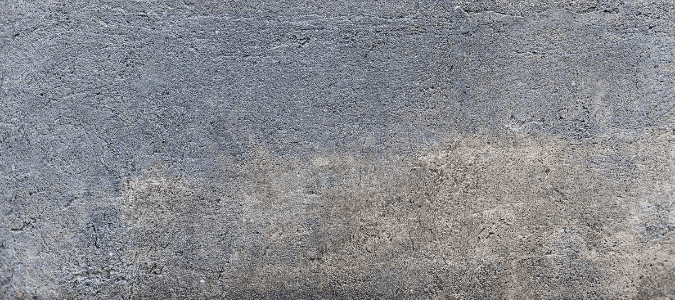
Damage From Power Washing
While concrete is among the strongest building materials available, it is not immune to wear and tear. Cracks, spalling and imperfections can develop over time, particularly on driveways that get a lot of foot and car traffic. A pressure washer delivers water 30 to 80 times stronger than your garden hose.
You know you’ve damaged your concrete due to a bad power washing job if it looks etched, creating an uneven surface and an unappealing driveway or surface. However, etching and other types of damage to concrete is not always due to extreme pressure, and could have existed before you removed the layer of dirt and grime that was on top of a surface.
If you recently installed concrete, you should hold off on power washing temporarily. Concrete needs at least a year to bond in a way that can handle this type of pressure. If you need to clean concrete without using so much pressure, you can try mixing water with dishwashing detergent and scrubbing off the stain or discoloration yourself.
Another type of concrete damage we come across is when homeowners power wash their concrete too frequently. Concrete should be power washed annually, so if you power wash your concrete once a month (or even more frequently), it’s more likely to wear down and be subject to damage.
Keep in mind that if you switch from power washing your concrete to another type of surface, such as your outdoor furniture, you’ll probably want to decrease the amount of pressure. Wooden decks can benefit from pressure washing, but some can get clean with the use of a garden hose. Power washing your roof is generally a bad idea, since you can be thrown off balance if you turn on the machine while you are on a ladder. Shingles can also be dislodged by a pressure washer. It’s generally also a bad idea to pressure wash your car, since your paint can be damaged in the process. Even contact on your skin from a high-pressure spray can cause lacerations and bruises, and eye injuries can send you to the hospital.
There are also some homeowners who don’t necessarily have etching on their concrete, but there are marks from power washing—so, what can you do about those?
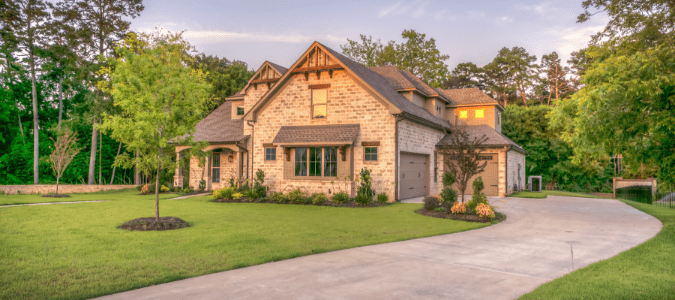
How To Remove Power Washer Marks
If you do find yourself leaving marks on your concrete, don’t fret. Leftover marks are a lot easier to deal with than etches or actual damage.
Take a look at the concrete surface that you have just power washed. You might see some leftover debris or pieces that didn’t make it off the surface. If you feel confident in your power washing abilities, you can go back over the concrete with a much broader nozzle. Or you can simply brush it off or use a gentle spray to remove the debris. Usually, these marks come from rushing through the job. If you start seeing marks while you are pressure washing, slow down a bit and make sure to go over each section thoroughly before moving onto the next area.
While most homeowners just deliver water in a high-pressure spray to remove marks on a surface, you can also try using a detergent to remove marks or discoloration. If you go this route, you should use a smaller nozzle when applying detergent. The detergent you purchase should have more detailed instructions on how to apply the product. If you follow those directions, you should get the best results with minimal power washer marks.
Sometimes marks are not from the power washer itself but from oil, grease or more stubborn build-up. In those cases, you can experiment with a different nozzle or get a bit closer to see if a higher degree of pressure removes the marks. If the power washer marks make you nervous about picking up the nozzle again, it’s time to call in a professional.

Additional Power Washing Tips
What else should you keep in mind before you start pressure washing your concrete?
Do Your Homework
Regardless of the size of your job or how long you think you will be using the power washer, you should take precautions. All that power can make a lot of noise, so before you rent or buy a power washer, do some research. Some models make more noise than others, which may be a consideration if you don’t want to bother your neighbors.
In addition to wearing proper clothing, safety experts recommend protecting your ears with earmuffs or headphones, even if you’re using a safer or smaller model. In addition, wearing gloves, goggles and long-sleeved clothing can prevent any exposed skin from feeling the pressure. Try to sweep the area you want to power wash so you don’t risk having rocks or other debris hit you or someone nearby. Never point the nozzle at a person so that you can avoid any possible injuries.
Be Cautious About The Environment
Power washing may be prohibited if your area is going through a drought. Even without these restrictions, it’s important to consider the environment and wasting water. If you follow our tips on properly power washing your home or property, you shouldn’t have to waste water, but be mindful with how much you are using.
Power washing can be more than just water.
Take a look at the ingredients in any cleaning products you use with your power washer. Are they environmentally-friendly? Could they cause damage if they end up on your lawn or in the sewers? Here are some ingredients you may want to avoid:
- Hydrofluoric acid
- Muriatic acid
- Sodium hydroxide
- Bleach
Consult The Professionals
Homeowners power washing their concrete can often cause accidental damage, either to their home or themselves. In addition to concrete damage, power washing horror stories include stripping paint off of houses, ripping off siding and shingles, damaging wood decks, destroying car paint jobs and even causing serious injuries.
ABC Can Safely Power Wash Your Surfaces
If you’re feeling unsure of your power washing abilities, call in the professionals. The experienced technicians at ABC Home & Commercial Services use commercially-designed power washers with the ability to blast dirt and debris with both hot and cold water. Our environmentally-friendly products hit dirt hard without harming sensitive areas around the surface. Our team has worked with all types of surfaces, including concrete, and they know just how important it is to use a power washer properly. After all, you can’t undo the damage that you’ve done once you’ve turned on a power washer and realized you’ve put far too much pressure against the siding of your house, your deck or your driveway. With ABC’s help, you can improve your curb appeal, get help with other items on your home maintenance checklist and enjoy more time with friends and family.
